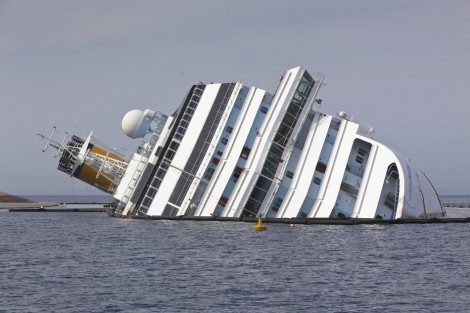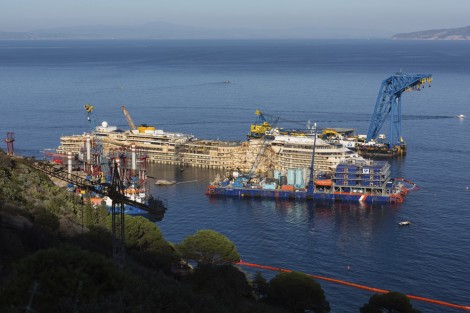Is the doomed Costa ship Captain a victim of ‘Miscarriage Of Justice’?
I’m sorry this is quite long but I guarantee you, it is worth reading every bit. I promise.
Anyone who works in the cruise industry – and many who don’t – remember exactly where they were when the news broke. On that fateful night in January 2012, Costa Concordia sank after hitting a reef off the coast of Giglio. I was on my way to my dads. I’d just stopped to put fuel in the car, started up the engine and the news came on. I’m not sure how long I sat there for, stunned into silence, just listening to what the news reporter was telling us.
Over the coming days, we heard how the Captain, Francesco Schettino, had abandoned the ship and his passengers. We even got to hear the conversation that took place between Schettino and Gregori de Falco of the Livorno coast guard. From that moment on, de Falco is labelled a hero and the Captain a murderer.
Francesco Schettino: ‘Right now, the boat is capsized.’
De Falco: ‘I understand that. But listen. There are people coming down the ladder of the prow. Go up that ladder, get back on that ship and tell me how many people are still on board. Is that clear? Tell me if there are children, women and what kind of help they need. And tell me the exact number in each of these categories. Is that clear? Listen Schettino. You may have saved yourself from the sea but I will put you through a lot of trouble. You will pay for this, Damnit!’
Francesco Schettino: ‘I am in a lifeboat beneath the ship. I haven’t gone anywhere, I am here’
De Falco: ‘What could you be coordinating from there? Get on board the ship! Coordinate the rescue from aboard the ship. Are you refusing to follow orders?’
Francesco Schettino: ‘I can’t go because another lifeboat is stopped.’
Francesco Schettino: ‘How many are dead?’
De Falco: ‘I don’t know. One that I’ve heard of. But you’re the one who is supposed to be telling me this. Christ!’
Francesco Schettino: ‘But you do realise it is dark here and impossible to see anything?’
De Falco: ‘So what do you want to do? Go home, Schettino? It’s dark and you want to go home? Get on the prow of the ship and tell me what needs to be done, how many people are there and what they need. Now!’
Schettino was sentenced on February this year to 16 years in prison for involuntary manslaughter.
However, in a world exclusive interview, Schettino has claimed he never abandoned the ship and after evidence has been provided, his story is now supported by Norwegian accident investigators. And the details of what really happened that night are slowly emerging.
Schettino is an experienced Captain, having navigated ships on most of the worlds water including the tricky Norwegian Fjords.
Before leaving the docks prior to the event, Schettino has requested the ship pass closer to the island of Giglio as a gesture.
A safety clearance from the island of 926 meters on the ships port side is planned and then plotted into the automated navigation equipment. Schettino, nontheless, explicity tells the crew that these kind of massages should always be navigated manually.
Upon his arrival on the bridge, Schettino notices that the first officer is sailing the ship on automation.
Schettino: ‘Hey, what happened to manual steering?’
Schettino leaves to call his friend. In the background he hears his senior officer order the helmsman to switch to manual steering. The helmsman then shouts to Schettino ‘We’re going 290 degrees’.
Schettino then believes that the helmsman has been following his previous orders and the ship is on the correct course. Until he sees that they are headed straight for the island of Giglio.
In court, the first officer will claim that he believed Schettino to be in command from the moment he entered the bridge.
Schettino orders a maneuver to try to get the ship back on course.
‘When I took over, I was tempted to shout ”hard to starboar”, but such an abrupt maneuver would have meant a risk of capsizing. So I said ”starboard 10”, and before we reached 10 on the radar I ordered”starboard 20”, so we’d be turning with a slight delay. Then I ordered hard to starboard’ the Captain says
Schettino knows that there is a chance that the ships stern will hit the reef even before the maneuver is complete.
‘Perhaps the helmsman didn’t grasp the logic of the order, perhaps he didn’t understand what I was saying. Later, it was confirmed that the helmsman understood neither Italian nor English. As captain, I should have made sure the ship had routines for all crew on board, ensuring both their qualifications and grasp of command language. And I should have reported this back to the cruise line’s crew division. But both the first, second and third officer, standing right behind me, should in theory also have checked to see whether the order was being complied with.
I am not saying this to lay the blame on the cruise line or others in the crew. But there seems to be this perception that the captain alone steers the ship. People don’t understand that it’s a whole team and a big system behind it all.’
At 2145, after a heavy vibration is heard throughout the ship, Schettino immediately knows that the ship has his the reef, but at this stage is unaware of the extent of the damage.
Modern ships can stay afloat as they have several waterproof bulkheads which limit flooding even if the underwater hull is breached.
Schettino states that he doesn’t want to cause a panic, worrying that people might jump off the ship and into the water. At this stage, he’s unaware that the damage is a 36 meter long hole.
This is where it gets interesting and we learn a lot of things we haven’t yet heard.
The power goes. All the lights go out. The backup generator isn’t working. The Captain received changing reports on the number of engine rooms affected and it’s 30 minutes before he’s advised of the extent of the damage.
Schettino states: ‘Had I grasped the seriousness of the collision at 21.45, and then followed the written procedures as the court says I should have, I would have spent an hour counting passengers and then half an hour evacuating them. The time would have been 23.16. During my trial it was confirmed that, had I followed procedure, the ship would have sunk at 23.10. Thousands would have lost their lives’
In a conversation between the coast guard and cruise line it’s decided they agree with the Captains decision to let the ship drift into shallower waters before initiating an evacuation.
At 2254 the ships stern lands on the ocean floor.
The Captain believes the ship is now firmly aground.
He then orders the lifeboats to be lowered, still ensuring the ship is drifting away from the reef. To ensure the weight of the ship remains balanced and to prevent her capsizing more than is already so, he orders them to first be lowered on the starboard side and then the port side. At this point, Schettino is not advised that there is a problem with three of the lifeboats.
He then hails a patrol boat in the water below after making his way to the upper deck of the stern. Audio recordings have now been supplied to validate this information.
The confirm the stern to have run aground. At 2350, Schettino makes his way back to the bridge en route to his cabin. At the bridge, he is ensuring the ship is holding her position. Shortly after, documents, books and binders start tumbling down.
Schettino crawls, one foot on the floor and the other on the corridor wall and eventually reaches the vessels starboard side.
He meets the crew captain on deck three where the shuttle traffic of patrol boats is being supervised. The last of the passengers has just been evacuated as the sound, much like hundreds of windows being smashed, is heard.
As the ship topples, the crew captain falls into the sea. At 0017 Schettino jumps down onto the roof of a lifeboat floating below, immediately reaching his arm down through the sunroof to gain control of the lifeboat and steering it away from the now capsizing ship which is capsizing over them.
After then climbing onto a reef 80 maters from the wreckage, Schettino instructs the rescue boats to head for the starboard side to pick passengers out of the water.
And this is the moment he receives the first call from De Falco – the man who is about to make him one of the most hated people in Italy.
‘Vada a bordo, cazzo!’ – Get back onboard, damnit!
Arne Sagen, a Norwegian accident investigator has analyzed every piece of information which has now been released including all of the conversations recorded between all parties involved and he says the following:
‘De Falcos interpretation of events, that the captain was fleeing in a life boat, is nothing less than an assassination of character without equal in maritime history. In addition to dismissing the captain and making himself head of the operation, the conversation further shows that De Falco at this moment was not aware that the ship had capsized completely. While hundreds of people were climbing down the side of the ship, he ordered the captain back aboard the ship on a ladder that had now been submerged in water.
De Falco was not at any point willing to listen to the captain’s explanation of the situation. That conversation, also broadcasted on an open radio frequency, prepared the ground for the court’s treatment of Schettino. The captain performed an excellent rescue, being the last man to jump overboard from the ship as it was capsizing on top of him. After that, he kept on rescuing people out of the sea. He is no coward, he is a hero. I trust that the Italian high court will call on maritime expert witnesses this time and that Schettino will be acquitted.’
So, what do you think? This has certainly given me a lot to think about. And one last point that Sagen makes:
‘My first response was why the cruise line would hire that sort of man as the captain of a cruise ship (if everything they claim is true). But of even graver concern: The agreements between the insurance companies and the cruise lines state that the cruise lines are awarded full compensation in the event of an accident where the captain is found to be at fault. At the same time, it is the cruise line’s duty to ensure that all personnel aboard the ship have proper qualifications’ Sagen says.
About Me

I've worked in the Travel Industry since 1998. I started straight from college after obtaining an Advanced GNVQ Qualification in Travel and Tourism. I specialise in Cruise and Cruise and Stay Holidays so if that's what you're after, you've come to the right place. I have 3 children - Aimee…
Read more

